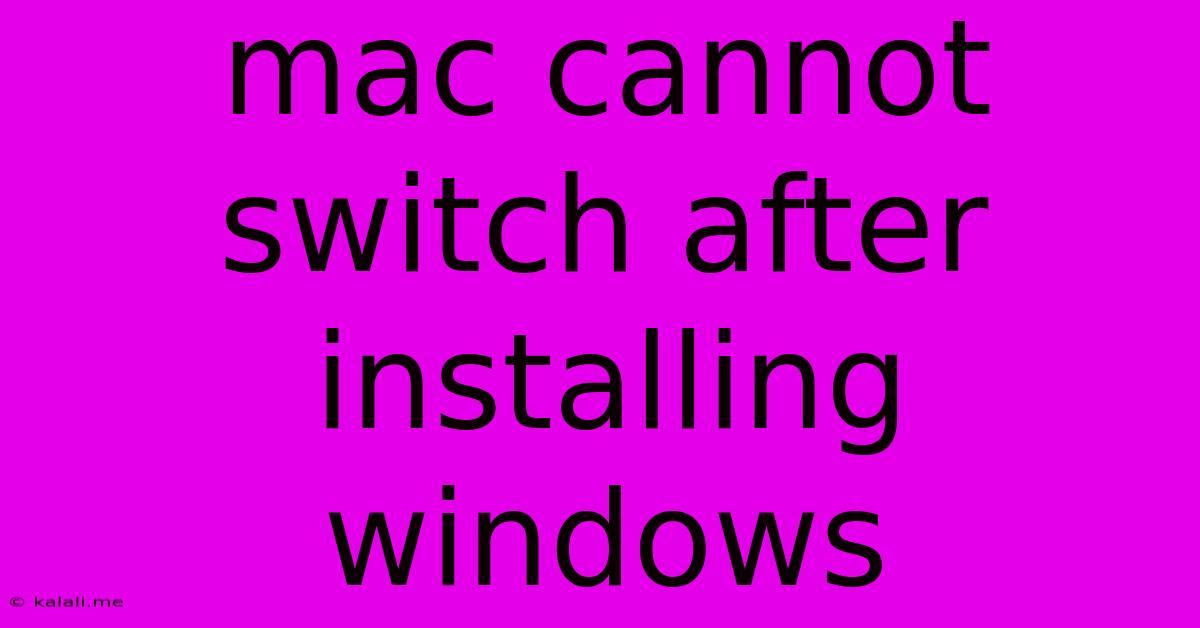Mac Cannot Switch After Installing Windows
Kalali
Jun 07, 2025 · 4 min read

Table of Contents
Mac Won't Switch After Installing Windows: Troubleshooting Dual Boot Problems
So, you bravely embarked on the journey of installing Windows on your Mac using Boot Camp, and now your Mac refuses to boot into macOS? Don't panic! This is a common issue, and often solvable with a bit of troubleshooting. This guide will walk you through the most likely culprits and solutions to get your Mac booting back into macOS.
This article covers common problems encountered when a Mac fails to switch between macOS and Windows after a Boot Camp installation. We'll explore troubleshooting steps, focusing on restoring the boot process and addressing potential boot loader conflicts.
Understanding the Boot Process
Before diving into solutions, it's helpful to understand the basic boot process on a dual-boot Mac. Your Mac's firmware (EFI) searches for bootable partitions. After a Boot Camp Windows installation, it should find both your macOS partition and your Windows partition. A boot manager, usually the Boot Camp Support Software, handles selecting which operating system to load. If this process breaks, your Mac might only boot into one OS or not boot at all.
Common Causes and Troubleshooting Steps
Here are the most frequent reasons why your Mac won't switch after installing Windows, along with detailed troubleshooting steps:
1. Boot Camp Support Software Issues:
- Problem: The Boot Camp drivers might be corrupted or missing. This can prevent the boot manager from functioning correctly.
- Solution:
- Reinstall Boot Camp Drivers: Try reinstalling the Boot Camp drivers from your macOS installation media (or a downloaded copy if available). This often resolves minor glitches.
- Repair Disk Permissions (macOS): After reinstalling the drivers, repair disk permissions in Disk Utility within macOS (if accessible). This can help resolve any file system inconsistencies.
- Boot Camp Assistant: Run Boot Camp Assistant again. In some cases, rerunning it can repair or update necessary components.
2. Boot Loader Problems:
- Problem: The boot loader (responsible for selecting the OS) might be damaged or overwritten during the Windows installation.
- Solution:
- Boot into Recovery Mode: Restart your Mac and hold down Command + R until the Apple logo appears. This will start macOS Recovery.
- Reinstall macOS: From Recovery, choose "Reinstall macOS." This process typically repairs the boot loader without deleting your data (unless you select the option to erase the disk). Caution: Back up your data before attempting this.
- Disk Utility (First Aid): Before reinstalling macOS, run "Disk Utility" from Recovery and select your macOS partition. Run "First Aid" to check for and repair any disk errors.
3. Incorrect Boot Order:
- Problem: Your Mac's boot order might be set to only boot from the Windows partition.
- Solution: Access your Mac's startup disk settings. The method varies slightly depending on your Mac model:
- Older Macs: You might see the startup disk selector when starting up (holding down the Option key).
- Newer Macs: Access System Preferences > Startup Disk (after booting into macOS). Select your macOS partition as the startup disk.
4. Hardware Issues (Less Likely):
- Problem: While rare, a hardware problem could be the culprit.
- Solution: This requires a more advanced level of troubleshooting. If none of the above solutions work, consider seeking professional assistance.
5. Partition Issues:
- Problem: The partitions might be improperly configured or damaged during installation.
- Solution:
- Disk Utility: Use Disk Utility (in Recovery Mode) to examine your partitions. Look for any errors or inconsistencies.
- Re-Partition (Advanced): This is an advanced step and should only be attempted if you're comfortable with potentially losing data. It may involve completely re-partitioning your drive and reinstalling both operating systems. Proceed with extreme caution, and back up your data first.
Prevention is Key
To prevent these issues in the future, it’s crucial to follow these best practices when installing Windows on a Mac using Boot Camp:
- Back up your data: Always back up your important files before making any significant system changes.
- Use a clean installer: Use a clean installation of Windows, not an upgrade from an existing installation.
- Follow Apple's instructions carefully: Follow the Boot Camp Assistant's instructions precisely.
- Keep your software up-to-date: Keep both macOS and Windows updated with the latest patches and drivers.
By systematically working through these troubleshooting steps, you should be able to resolve your dual-boot problem and get your Mac happily switching between macOS and Windows once again. Remember to always back up your data before attempting any major system repairs. If the problem persists, seeking professional help may be necessary.
Latest Posts
Latest Posts
-
How To Fix Ripped Drywall Paper
Jun 08, 2025
-
Find Position From Velocity Time Graph
Jun 08, 2025
-
Shes Like A Dog Bone To Me Meaning
Jun 08, 2025
-
Folder Of An Image Layer In Gimp
Jun 08, 2025
Related Post
Thank you for visiting our website which covers about Mac Cannot Switch After Installing Windows . We hope the information provided has been useful to you. Feel free to contact us if you have any questions or need further assistance. See you next time and don't miss to bookmark.